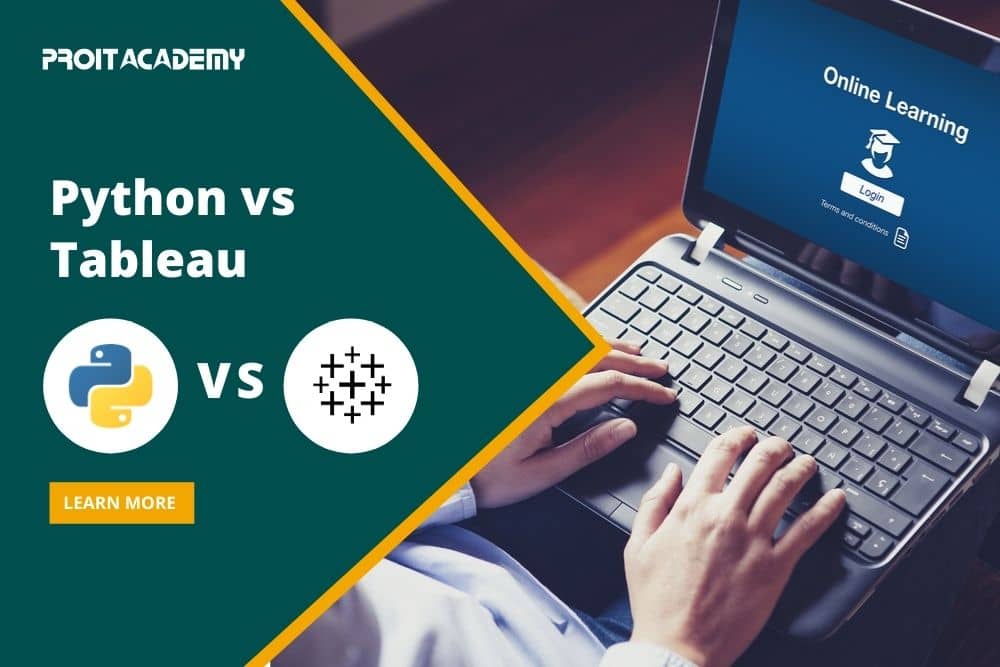Difference between Python and Tableau
What is Tableau?
Tableau is a rapidly increasing data visualization tool, In the business intelligence field. It is considered the best solution to transform the unprocessed data set into a readily understandable format. It can handle without any technical expertise or coding knowledge.
You will use the integrated data connectors to link to any database until you launch Tableau.
You can quickly extract the data and connect it to the Tableau data engine, i.e., the desktop table. Data analytics and data engineers work with the information they obtain and convert it into visualization. You should transform them into static files and share these with the user. The users can access these dashboards through the Tableau Reader. The data is available on the Tableau Server platform of the company. Even on your smartphones, users can access those files anywhere. Tableau Server facilitates communication and delivery and automation as well as security models. Learn more at Tableau Training in Pune
What is Python?
In several fields of software development worldwide, Python developed itself as a dynamic programming language.
Python is a dynamic, interpretive programming language. The Dutchman Guido van Rossum developed Python in the early 1990s. Today, several developers around the world have developed this language as an open-source project. In the foreground, for Python’s future development.
The Python programming language follows significant programming concepts for today’s software development methods: structured programming, object-oriented programming, and aspect-oriented programming. Due to the powerful add-on packages available to specific applications, high-performance applications are developed in Python.
Python language constructs often allow the selective application of ReUse, KISS (Keep it short and straightforward and don’t repeat yourself) principles in software development. In particular, the enhancement of ReUse concepts is an exciting topic in researching more efficient software development. It led to research work on the so-called patterns at universities around the world.
Python program code is interpreted transparently and then executed by the interpreter into an intermediate code. Python C Python Interpreter, developed in programming language C, is used in Linux, Mac OS, Windows, and others for all of the most common operating systems. Therefore, Python programs are platform-independent.
Several companies, including Google, used the Python programming language as the internal script language for developing web applications. Google’s Software Engine is a strong example of web apps. Since December 2005, Guido van Rossum has worked for Google. In a 2008 lecture on Youtube, he discusses on Google’s application site the problem of fast development with Python. ZODB, an object-oriented database known as an object store, is typical for Python applications’ persistence data. These robust and safe web platforms are used by large organizations or companies such as NASA or even the CIA.
In 2018, Python earned 22.8% of the total, only taking the first spot in Java with 22.5%. Python ranked second with a 22.2 percent share the month before. Python was also the only language among the top 20 with substantial growth (5.5 percent). The TIOBE index originally ranked Python the 2018 programming language title, winner. A formula for language analysis in search engines such as Google, Bing, and Wikipedia is used to examine TIOBE indexing, something like the PyPI. The formula calculates the number of skilled engineers, courses, and third-party language suppliers. Learn more at Python Classes in Pune
TabPy
Python’s TabPy packages allow you to perform Python soft code on the Table and display results in Tableau images, which help you quickly develop the state-of-the-art analytical application. Excellent visualization of data, driven by TabPy powerful data science algorithms, gives a split approach. One of the significant advantages of Python Tableau algorithms is that it enables users to sync parameters and assess their data analysis impact in real-time with each change to the dashboard.
By combining both Python and Tableau’s capabilities, there are huge powerful possibilities. In Tableau, you can use Python code to build an interactive dashboard that puts a time series prediction in service. Or, using the Python Plotly Dash, you can create an interactive user input dashboard. Integrating Tableau and Python can be outstanding in any business in the field of data science.

Book Your Time-slot for Counselling !
Python features
Easy to code
Python is the robust language of programming. Compared with other languages such as C, C#, Java, Javascript, etc., Python is straightforward. The coding is straightforward in python language, and in a few hours or days, anyone can learn python fundamentals. The language is also well-functioning for developers. Because of this feature, It is highly demanded in the top 5 Job Oriented Courses.
Free and Open Source
It ensures that the source code is now accessible to the public since it is open source. You will therefore download it, use it, and share it.
Object-Oriented Language: Python is a programming language that focuses on object-oriented programming. Python facilitates the encapsulation of object-oriented language and class concepts, respectively.
GUI Programming Support:
Use the Python module PyQt5, PyQt4, wxPython to create graphical interfaces.
PyQt5 is the most common Python graphical application.
High-Level Language:
Python is an excellent language of programming. We don’t need to remember or maintain the system architecture when writing Python programs.
Extensible feature:
Python is a language extensible. Some Python code can be written in C or C++.
Python is a Portable language:
We can execute this on any platform.
Python is an Integrated language:
Since combined with other languages, Python is also an integrated language.
Interpreted Language:
Python is interpreted as Python code is run on a line-by-line basis at a time. No need to compile a python code like other C, C++, Java languages is required, which makes debugging the code much more straightforward. The Python source code is converted into a quick byte code.
Large Standard Library
Python has a huge standard library that offers a large set of modules and functions such that your code does not have to be written on all things. Python provides a lot of libraries for regular expressions, unit testing, web browsers, respectively.
Dynamically Typed Language:
It means that the variable type is decided not in advance, and we don’t have to specify the variable type at runtime.
Features of Tableau
Tableau Dashboard
The Tableau Dashboards allow a balanced view of your data through displays, visual objects, text, etc. Dashboards are very informative because they can display data as stories and allow multiple viewing and objects to be added, including a wide range of layouts and formats and allowing users to deploy appropriate filters. You can also copy a dashboard or its particular items from a workbook to another.
Collaboration and Sharing
Tableau provides helpful ways of immediately collaborating with other users and exchanging data in real-time as sheets, visuals, dashboards, etc. You can exchange data from different sources such as on-site, on-cloud, hybrid, etc. It is secure. Collaborate and exchange results immediately and quickly help obtain rapid data reviews or feedback leading to the improved overall analysis.
Live and In-memory Data
Tableau ensures connectivity as in-memory data, whether to live data sources or extracted data from external data sources. The customer has the freedom without limitations to using data from more than one kind of data source. You may use the data directly from a database source by establishing live data or by keeping it in the memory by extracting information from a data source, as necessary. Tableau offers additional data connectivity support functionality, including automatic extract refreshes, notification of a failure of a Live connection by the user, etc.
Data Sources in Tableau
Tableau provides many methods for connecting and extracting data from data sources. Tableau has data sources, including on-site files, spreadsheets, relational databases, nonrelational databases, data warehouses, big data, and cloud data. A safe connection to each of the Tableau data sources can quickly develop. Data from other sources can create a combined view of the data as a visualization method. Tableau supports different connectors such as Presto, Google Analytics, Hadoop, Amazon Athena, SQL Server, and several more.
Maps
Tableau’s map is just yet another significant element. Tableau has a lot of knowledge preinstalled on maps, including cities, mailing codes and administrative boundaries, etc. Thus, the Tableau maps are highly descriptive and comprehensive. You can generate information maps in Tableau using your data and add different geological layers to the chart, as per your requirements. Tableau’s heat maps, flow maps, Choropleth-maps, point-Distribution maps, etc., are different.
Robust Security
Tableau specializes in data care and consumer security. This device features a fool-proof system based on data connections and user access authentication and permission systems. Also, Tableau offers you free to integrate with other protocols for security like Active Directory, Kerberos, etc. It is interesting to note here that Tableau practices filtering in row levels that help to maintain secure data.
Mobile View
Tableau acknowledges today’s value in mobile phones and has a mobile Tableau application. You can create your dashboards and reports in such a way as to be mobile-compatible, and Tableau can create personalized mobile layouts of your mobile dashboard. The customize option allows the addition of new phone designs, offline interactive views, and more. Therefore, the mobile vision enables Tableau users to handle their data more flexibly and more accessible.
Ask Data
The Tableau data request function enhances consumer preferences worldwide. This function makes it easy to play with data much as we do with Google. You have to type a question in natural language for your data, and Tableau provides you with adequate answers. The answers are not only textual but also visual. For example, if you have already searched for what is present in a bar graph, the ask data alternative would search for you immediately and open the bar chart. Such features make deep data diving and finding new ideas and patterns simpler for developers.
Trend Lines and Predictive Analysis
Tableau’s use of time series and predictions is another extremely valuable function. The strong background and dynamic front end of Tableau make easy creation of trend lines and forecasting possible. Data predictions like forecasts or trend lines can be easily obtained using the fields to select these options and drag-and-drop.

Do you need help to create your career path ?
Comparison of Python Vs. Tableau
The Following are the Difference between Python and Tableau
Python
● General language programming for Data Analytics and Visualization may also use.
● Python has sufficient whitespace and is known for its readability in code. It consists of structures for which it’s simple to perform straightforward programming on small and large scales.
● In Python, the Seaborn library offers a high graphical interface for platform architecture that identifies designs and emphasizes critical elements.
● Loved by developers because of simple and concise syntax.
● Python is a lightweight open-source language backed by an enormous standard library.
● The Open-Source Initiative has agreed to develop Python under an open-source license, and It is also publicly available and can also be distributed for commercial purposes. Python Software Foundation managed it.
● Certain applications, such as matplotlib, ggplot, and seaborn, can be used to have an IT team with good programming experience. With these, with graphs, you can simplify complex data.
● Several libraries with graphing.
● Is excellent for streaming data processing.
● Difficult to do quick and visual data out of the box
● Quick dark-style data analysis
● Python provides a wide range of data collection modules and tools from several sources.
Tableau
● Tableau is a product that is primarily used in Business Intelligence for immersive data visualization. It was created 16 years ago by Chris Stolte and Christian Chabot.
● Tableau is used to explore and analyze relation databases, location, including items, and years. Tableau extracts a massive amount of data and stores it in its exclusive memory data engine, which it can access at any time.
● Tableau can help to create superb user interfaces.
● Minimum programming skills required
● Will consume different file types instantly
● Will use different kinds of files instantly
● It can be linked to various databases, including relational, cloud, flat, and spreadsheet databases.
● Tableau can be very challenging to translate data in viable formats with web scraping, NoSQL databases, and nested data sources. Tableau is used to build and distribute dynamic data dashboards without problems. With easy-to-understand visuals, you can narrate dynamics, changing trends, and density distributions.
● Tableau allows you to interpret data in real-time and combine data easily.












